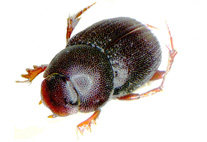Abstract
Sirovena Bouček (Chalcidoidea: Pteromalidae, Pireninae) was known only from females of its type species, S. stigma Bouček, 1988. Males and host associations were both unknown. Both sexes of a second species of Sirovena, S. costallifera sp. nov., reared from Ficus microcarpa L. (Moraceae) in Yunnan, China, are described based on morphological characters and mitochondrial COI sequences. The males of S. costallifera show sexual dimorphism in body coloration, structure of the antennae and notauli, and body sculpture. Reliable host records of Pireninae are Cecidomyiidae (Diptera). Because midges also parasitize some figs, we speculate that S. costallifera is a parasitoid of some cecidomyiid midge that attacks fig syconia. A key to differentiate the two species is provided.
References
Bai, L.F., Yang, D.R. & Compton, S.G. (2008) A gall midge inhabiting the figs of Ficus benjamina in Xishuangbanna, south-western China. Symbiosis, 45(1–3), 149–152.
Beardsley, W.J. (1998) Chalcid wasps (Hymenoptera: Chalcidoidea) associated with fruit of Ficus microcarpa in Hawai'i. Proceedings of the Hawaiian Entomological Society, 33, 19–34.
Bouček, Z. (1988) Australasian Chalcidoidea (Hymenoptera): A Biosystematic Revision of Genera and Fourteen Families, with a Reclassification of Species. CAB, International, Wallingford, UK., 832 pp.
Bouček, Z.(1993) New taxa of North American Pteromalidae and Tetracampidae (Hymenoptera), with notes. Journal of Natural History, 27, 1239–1313.http://dx.doi.org/10.1080/00222939300770741
Chen, Y.R., Chuang, W.C. & Wu, W.J. (1999) Chalcid wasps on Ficus microcarpa L. in Taiwan (Hymenoptera: Chalcidoidea). Journal of Taiwan Museum, 52(1), 39–79.
Cook, J.M. & Rasplus, J.Y. (2003) Mutualists with attitude: coevolving fig wasps and figs. Trends in Ecology & Evolution, 18(5), 241–248.http://dx.doi.org/10.1016/S0169-5347(03)00062-4
Cook, J.M. & West, S.A. (2005) Figs and fig wasps. Current Biology, 15(24), 978–980.http://dx.doi.org/10.1016/j.cub.2005.11.057
Farache, F.H.A., Do, Ó, V.T. & Pereira, R.A.S. (2009a) New Occurrence of non-Pollinating Fig Wasps (Hymenoptera: Chalcidoidea) in Ficus microcarpa in Brazil. Neotropical Entomology, 38(5), 683–685.http://dx.doi.org/10.1590/S1519-566X2009000500020
Herre, E.A. (1999) Laws governing species interactions? Encouragement and caution from figs and their associates. In: Herre, E. A. (Eds), Levels of selection in evolution. Princeton Unversity Press, pp. 209–237.
Jousselin, E., Rasplus, J.Y. & Kjellberg, F. (2003) Convergence and coevolution in a mutualism: evidence from a molecular phylogeny of Ficus. Evolution, 57(6), 1255–1269.http://dx.doi.org/10.1554/02-445
Kerdelhue, C., Rossi, J.P. & Rasplus, J.Y. (2000) Comparative community ecology studies on old world figs and fig wasps. Ecology, 81(10), 2832–2849.http://dx.doi.org/10.2307/177345
Kumar, S., Nei, M. & Dudley, J. (2008) MEGA: a biologist-centric software for evolutionary analysis of DNA and protein sequences. Briefings in Bioinformatics, 9(4), 299–306.http://dx.doi.org/10.1093/bib/bbn017
Meiswinkel, R., Labuschagne, K. & Goffredo, M. (2004) Christopher Columbus and Culicoides: was C. jamaicensis Edwards, 1922 introduced into the Mediterranean 500 years ago and later re-named C. paolae Boorman 1996? Veterinaria Italiana, 40(3), 340–344.
Miao, B.G., Yang, D.R. & Liu, C. (2011) The impact of a gall midge on the reproductive success of Ficus benjamina, a potentially invasive fig tree. Biological Control, 59(2), 228–233.http://dx.doi.org/10.1016/j.biocontrol.2011.07.007
Mitroiu, M.D. (2010) Revision of the Palearctic species of Macroglenes Westwood (Hymenoptera: Pteromalidae). Zootaxa, 2563, 1–34.
Noyes, J.S. (2011) Universal Chalcidoidea Database, WWW electronic publication. Available from: http://www.nhm.ac.uk/research-curation/research/projects/chalcidoids/database/ (accessed 7 December 2012).
Rønsted, N., Weiblen, G.D. & Cook, J.M. (2005) 60 million years of co-divergence in the fig-wasp symbiosis. Proceedings of the Royal Society B Biological Sciences, 272(1581), 2593–2599. http://dx.doi.org/10.1098/rspb.2005.3249
Tippmann, H.F. (2004) Analysis for free: Comparing programs for sequence analysis. Briefings in Bioinformatics, 5(1), 82–87.http://dx.doi.org/10.1093/bib/5.1.82
Weiblen, G.D. (2002) How to be a fig wasp. Annual Review of Entomology, 47(1), 299–330.http://dx.doi.org/10.1146/annurev.ento.47.091201.145213
West, S.A., Herre, E.A. & Windsor, D.M. (1996) The ecology and evolution of the New World non-pollinating fig wasp communities. Journal of Biogeography, 23(4), 447–458.http://dx.doi.org/10.1111/j.1365-2699.1996.tb00006.x

